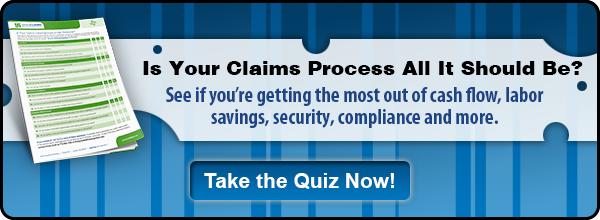 Winning the race to collect your money on time is everything. However, Medicare Secondary Payer[1] (MSP) may cause nursing home billers to trip up in their efforts to get payments as quickly as possible. Tripped too often, and providers may find themselves not quite reaching the monthly collection goal finish line. Worse yet, they may find themselves going backwards due to fines imposed for “knowingly, willfully, and repeatedly providing inaccurate information related to the existence of other health insurance or coverage.” Perhaps it’s time to get in shape regarding MSPs.
Winning the race to collect your money on time is everything. However, Medicare Secondary Payer[1] (MSP) may cause nursing home billers to trip up in their efforts to get payments as quickly as possible. Tripped too often, and providers may find themselves not quite reaching the monthly collection goal finish line. Worse yet, they may find themselves going backwards due to fines imposed for “knowingly, willfully, and repeatedly providing inaccurate information related to the existence of other health insurance or coverage.” Perhaps it’s time to get in shape regarding MSPs.
But first, what is MSP and why is it so important?
Conditioning exercise – know the terms of the game. Let’s start with primary payers. Primary payers are those which have the primary responsibility for paying a claim. Sounds simple, right? How does this apply to MSP? Medicare does not pay for services and items that other health insurance or coverage is primarily responsible for paying. In other words, Medicare is the secondary payer when it is not responsible for paying first; when it is not the beneficiary’s primary health insurance coverage. So, remember, only in the absence of other primary insurance or coverage does Medicare remain the primary payer. Examples include accidents where the auto insurance would eclipse Medicare, workers compensation, a fall whether at home or on public property, etc.
Are there any exceptions to the MSP requirements? No and Yes.
First, no. Federal law takes precedence over state laws and private contracts. It doesn’t matter what an insurance contract or state law may claim federal law always take precedence.
Second, yes. In the following situations, Medicare may make payment, assuming Medicare covers the services and you file a proper claim.
- A Group Health Plan (GHP) denies payment for services because the beneficiary is not covered by the GHP;
- A no-fault or liability insurer does not pay or denies the medical bill;
- A Workers Compensation (WC) program denies payment, as in situations where WC is not required to pay for a given medical condition; or
- A WC Medicare Set-aside Arrangement (WCMSA) is exhausted.
Conditioning note: When submitting a claim to Medicare, include documentation from the other payer stating the claim was denied and/or benefits were exhausted.
OK. With this understanding, you should be in shape and in racing trim. Let’s discuss 5 tactics to completing the collection race in good time.
1. Contact the COBC (Coordination of Benefits Contractor).
You may contact the COBC to:
- Verify Medicare’s primary/secondary status,
- Report changes to a beneficiary’s health coverage,
- Report a beneficiary’s accident/injury,
- Report potential MSP situations, or
- Ask questions regarding Medicare development letters and questionnaires
2. Know your responsibilities.
As a Medicare provider you should obtain billing information prior to providing services. You will need to:
- Gather accurate MSP data to determine whether or not Medicare is the primary payer by asking Medicare beneficiaries (or their representatives) questions concerning the beneficiary’s MSP status.
- Bill the primary payer before billing Medicare.
- For Part A, submit any MSP information on your Medicare claim using proper condition and occurrence codes on the claim.
- For Part B, submit an Explanation of Benefits (EOB) form from the primary payer on your claim with all appropriate MSP information. If submitting an electronic claim, provide the necessary fields, loops, and segments needed to process the MSP claim.
3. Gather accurate data from the MSP beneficiary.
You must determine whether Medicare is the primary or secondary payer for each inpatient admission prior to submitting a bill by asking Medicare beneficiaries about other coverage. You should also inquire through HETS (HIPAA Eligibility Transaction System).
The MSP Questionnaire
CMS developed an MSP questionnaire[2] for providers to use as a guide to help identify other payers that may be primary to Medicare. The questionnaire follows a logical step-by-step sequence of Yes/No questions involving whether or not:
- The beneficiary is receiving Black Lung (BL) Benefits
- The services are to be paid by a government research program
- Department of Veterans Affairs (DVA) has authorized and agreed to pay for your care at this facility
- The illness/injury was due to a work-related accident/condition
- The illness/injury was due to a non-work-related accident
- No-fault insurance is available
- Liability insurance is available
- The beneficiary is employed
- The spouse is currently employed
- The beneficiary has group health plan (GHP) coverage based on his or her own or a spouse's current employment
- The beneficiary has GHP coverage based on own current employment: does the employer that sponsors or contributes to the GHP employ 20 or more employees or 100 or more employees?
- The beneficiary has GHP coverage based on his or her spouse’s current employment: does the spouse’s employer that sponsors or contributes to the GHP employ 20 or more employees or 100 or more employees
- The beneficiary is covered under the GHP of a family member other than his or her spouse whose employer that sponsors or contributes to the GHP employs 100 or more employees
- The beneficiary has End Stage Renal Disease (ESRD) and has group health plan (GHP) coverage
- The beneficiary has received a kidney transplant
- The beneficiary has received maintenance dialysis treatments
- The beneficiary is within the 30-month coordination period that starts MM/DD/CCYY
- The beneficiary is entitled to Medicare on the basis of either ESRD and age or ESRD and disability
- The initial entitlement to Medicare (including simultaneous or dual entitlement) was based on ESRD
- The GHP is already primary based on age or disability entitlement
Race tactic: You should retain a copy of completed MSP questionnaires in your files or online for 10 years.
4. Avoid submitting a claim to Medicare without providing the other insurer’s information.
Medicare may erroneously pay the claim as primary if it meets all Medicare requirements, including coverage and medical necessity guidelines. However, if the beneficiary’s Medicare record in HETS indicates that another insurer should have paid primary to Medicare, Medicare will deny the claim, unless it may rightly pay conditionally.
5. Avoid the penalties to failure to filing correct and accurate claims with Medicare.
Medicare can fine providers, physicians, and other suppliers up to $2,000 for knowingly, willfully, and repeatedly providing inaccurate information related to the existence of other health insurance or coverage.
MSP is a serious matter you should carefully address BEFORE you file a claim. By following these five steps you will be in good shape to cross the collection finish line successfully and in good time.
[1] The term "Medicare Secondary Payer" is sometimes confused with Medicare supplement. A Medicare supplement (Medigap) policy is a private health insurance policy designed specifically to fill in some of the "gaps" in Medicare's coverage when Medicare is the primary payer. Medicare supplement policies typically pay for expenses that Medicare does not pay because of deductible or coinsurance amounts or other limits under the Medicare program.
[2] Medicare Secondary Payer (MSP) Manual, Chapter 3 - MSP Provider, Physician, and Other, Supplier Billing Requirements, 20.2.1 - Admission Questions to Ask Medicare Beneficiaries.
/Prime-Care-Technologies-Logo.png?width=191&height=55&name=Prime-Care-Technologies-Logo.png)



 LTPAC CFOs in the 21st century have to be concerned about many things. But in reality, much of what CFOs do revolves around getting paid on time in the amounts anticipated. Perhaps paying attention to the not-so-obvious factors influencing payment may be worth investigating.
LTPAC CFOs in the 21st century have to be concerned about many things. But in reality, much of what CFOs do revolves around getting paid on time in the amounts anticipated. Perhaps paying attention to the not-so-obvious factors influencing payment may be worth investigating. For CFOs, the bottom line matters, whether it’s the P&L or identifying what’s in the bank. Occasionally, though, it does help to know within the context of “what’s in the bank,” how the money gets there. Since Medicare Part A is a significant revenue source, being aware that just submitting a claim for Part A-covered days-of-service may not be enough can be helpful to supporting the organization’s efforts to create an impediment-free flow of cash to the bank.
For CFOs, the bottom line matters, whether it’s the P&L or identifying what’s in the bank. Occasionally, though, it does help to know within the context of “what’s in the bank,” how the money gets there. Since Medicare Part A is a significant revenue source, being aware that just submitting a claim for Part A-covered days-of-service may not be enough can be helpful to supporting the organization’s efforts to create an impediment-free flow of cash to the bank.
 Winning the race to collect your money on time is everything.
Winning the race to collect your money on time is everything.